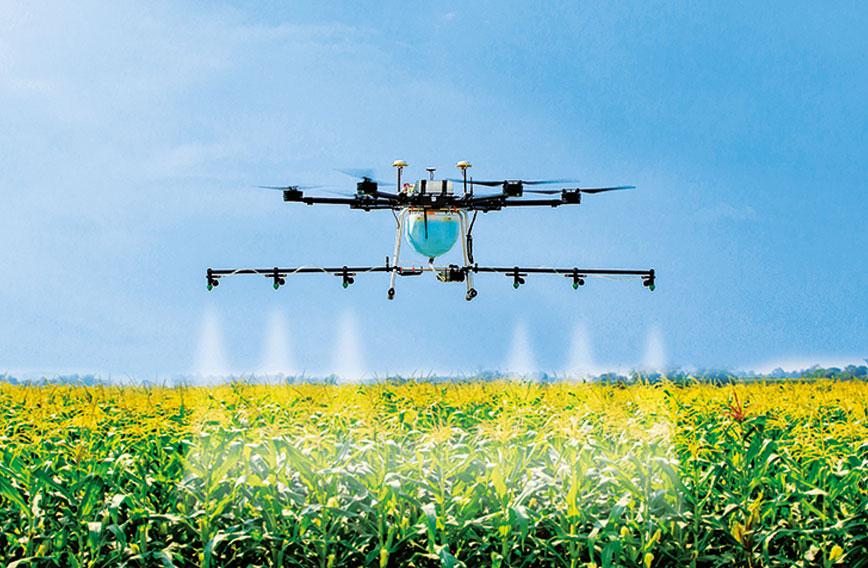
KIRAN KARNIK
Agriculture is now a comparatively small and decreasing part of India’s economy, accounting for just about 15 percent of the GDP. However, it is still the means of livelihood for 44 percent of our population. This mismatch between the two figures indicates high disguised unemployment, poor productivity and low incomes of those engaged in agriculture, with output per capita (of farmers) and per hectare both being dismally low. Migration from villages to urban areas will help only to a limited extent. The solution lies in big increases in agricultural productivity, and the creation of higher-income non-farm rural jobs. This piece explores how technology could play an important role in boosting the rural economy.
In the past, major increases in productivity were driven by hybrid seeds combined with high fertiliser inputs. The resulting ‘green revolution’ of the 1970s ended the derogatory ‘ship to lip’ food supply, dependent on imported grain. However, over the years, excessive use of fertilisers has degraded the soil. Free electricity facilitated the pumping of groundwater, encouraging a shift to water-intensive crops and a depletion of groundwater resources. These long-ignored side effects of the green revolution and of faulty policies are now starkly visible.
More recently, genetically-engineered seeds have led to a big increase in cotton output. Such genetically modified (GM) crops are, however, the subject of much controversy, especially for food items. Thus, BT brinjal, a well-proven technology, is banned in India. Yet, genetics holds tremendous promise: better nutrition, less water and pesticides, higher yields. At the same time, there is deep concern about the health impact of GM crops, especially their long-term effects. Therefore, while many countries permit the use of GM seeds, India is yet hesitant. Reportedly, though, imported edible oils extracted from GM seeds are sold here, but local use of such seeds is banned!
Our policy on GM foods should not be shaped by techno-evangelists and profit-driven seed companies, nor by dogma and Luddites. Genetics and bio-technology can revolutionise agricultural productivity; vague fears should not hold us back, but caution and scientific evidence must guide a decision.
Less controversial are drones. The agricultural use of these amazing unmanned aerial vehicles — to give them their proper name — is comparatively recent, but both, benefits and further potential, are already clear. Drones can capture images at the level of individual farms, enabling analysis to guide each farmer about crop health, the need for more water, fertiliser or pesticide, and providing yield estimates. The last is also used by insurance companies, enabling quicker assessment and payment for any crop losses. A newer use of drones is to carry and spray pesticides and fertilisers. This is part of ‘precision farming’, which provides optimal inputs at just the right time for each farm and thus enhances productivity and profitability. It also minimises pesticide and fertiliser use, with attendant environmental benefits, besides saving costs.
Another use of drone imagery is for terrain mapping to optimally locate bunds or check-dams for water storage and conservation. Growing problems related to water, made worse by extreme climate events like torrential rainfall or droughts, makes this a vital application of great value to farmers and rural life.
Satellite imagery and other data used for weather prediction have now become commonplace. Soil mapping, land-use classification and crop yield predictions are used for policy and planning, as also to take timely action (e.g., to import grains or edible oil, depending on the forecast yield). With the increasing power of data analytics, combined with machine learning and artificial intelligence, the models for weather prediction have become far more accurate. This, together with data on soil, water availability and past records, enables quicker and more accurate forecasts of yields. The ability to localise the prediction enables banks to decide on appropriate loans and insurance companies to decide on premiums for crop insurance. Others selling products in rural areas — from two-wheelers and tractors to soaps and soft drinks — can estimate likely demand. Overall, the gains to the rural economy are immense.
Photographs of a crop, taken on a smartphone, can be sent to an expert who — with the aid of AI — can respond with a diagnosis of crop health or disease and advise on corrective action: pesticide, more fertiliser or water, etc. Also available to the farmer via apps on the cell phone are market prices for his crop in different mandis (markets), weather forecasts and warnings. The online electronic National Agricultural Market (e-NAM) can bypass the traditional mandi, where the middleman calls the shots, and put power in the hands (literally, through the cell phone) of the farmer.
New technologies for storage, cold chains and processing of agricultural produce will all greatly aid farmers, while creating non-farm employment. Services to support these will add further jobs and income.
The IoT (Internet of Things) will enable soil moisture or crop (water) stress sensors to link with computers and pumps that will automatically release the required quantity of water (calculated through data analytics/AI models) at the right time. Ideally, water-saving drip irrigation and solar-powered water pumps will be used. New online platforms (some of which already exist) will bring the ‘sharing economy’ to rural areas, enabling Ola-like hiring of tractors or farm equipment on a pay-per-use basis through a simple cell phone app. This is of special value to small farmers, making possible far greater productivity and income for those who cannot afford the capital costs of such equipment.
These and many other technologies have the potential to transform agriculture. Most important, hundreds of entrepreneurs with innovative ideas are now working on AI models and apps of use in villages. Technology and these start-ups have begun to change the face of the farm economy; emerging technologies hold promise to truly revolutionise rural India in the near future.
Kiran Karnik is an independent policy and strategy analyst and a writer. His most recent book is eVolution: Decoding India’s Disruptive Tech Story (2018).
Comments
Currently there are no Comments. Be first to write a comment!




